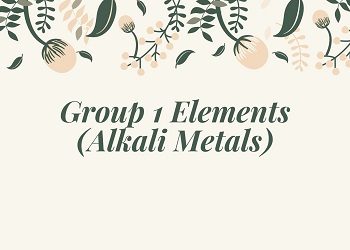Alkali Metals:
The elements Lithium (Li), Sodium (Na), Potassium (K), Rubidium (Rb), Caesium (Cs) and Francium (Fr) together constitute 1 group of the long form of Periodic table. These are collectively known as Alkali metals because their oxides and hydroxides are soluble in water and form a strong alkaline (basic) solution.
General Trends in Physical Properties of Alkali Metals:
(i) Electronic Configuration- The general valence shell electronic configuration of Alkali metals is ns1, where ‘n’ is the number of valence shell and ranges from 2 – 7. Thus, Alkali metals have only one electron in the s-orbital of their outermost shell.
| Element / Symbol | Atomic Number | Electronic Configuration |
|---|---|---|
| Lithium, Li | 3 | 1s2, 2s1 or [He] 2s1 |
| Sodium, Na | 11 | 1s2, 2s2 2p6, 3s1 or [Ne] 3s1 |
| Potassium, K | 19 | 1s2, 2s2 2p6, 3s2 3p6, 4s1 or [Ar] 4s1 |
| Rubidium, Rb | 37 | 1s2, 2s2 2p6, 3s2 3p6 3d10, 4s2 4p6, 5s1 or [Kr] 5s1 |
| Caesium, Cs | 55 | 1s2, 2s2 2p6, 3s2 3p6 3d10, 4s2 4p6 4d10, 5s2 5p6, 6s1 or [Xe] 6s1 |
| Francium, Fr | 87 | 1s2, 2s2 2p6, 3s2 3p6 3d10, 4s2 4p6 4d10 4f14, 5s2 5p6 5d10, 6s2 6p6, 7s1 or [Rn] 7s1 |
(ii) Physical State- Alkali metals exist as silvery white, light and soft metals. These are soft due to the presence of weak metallic bond in them.
(iii) Density- Because of their large size, alkali metals have low densities which increases on moving down the group from Li to Cs.
(iv) Atomic Radii- Atomic radii of alkali metals are largest in their respective periods which further increases on moving down the group from Li to Fr due to increase in screening effect which overcomes the effect of increased nuclear charge. Example- Li = 1.52Å, Na = 1.86Å, K = 2.27Å, Rb = 2.48Å, Cs = 2.65Å.
(v) Ionic Radii- Like atomic radii, ionic radii also shows an increasing trend on moving down the group. When an alkali metal loses its outer electron to form a cation, the nuclear charge exceeds the number of electrons and so cation contracts in size and, hence, a cation is always smaller in size than the corresponding atom. Example- Li = 0.60Å, Cs = 1.69Å.
(vi) Melting points and Boiling points- Alkali metals have low melting points and boiling points because of their large atomic size due to which weak forces of attraction operate in them and have loosely packed metal lattices. On moving down the group from Li to Fr, both melting points and boiling points decreases due to an increase in the number of electronic shells and screening effect.
(vii) Ionisation Energy- Because of their large atomic size, alkali metals have low ionisation energy. However, on moving down the group from Li to Fr, ionisation energy goes on decreasing due to increase in screening effect due to which Nucleus-valence shell attraction decreases and, hence, less energy is required for the removal of an electron. The second ionisation energy of alkali metals is quite high because the electron is now to be ejected from a cation which has already acquired the stable configuration of a noble gas.
(viii) Electronegativity- Due to their large atomic size and smaller nuclear charge, alkali metals have low electronegativity values and it further decreases on moving down the group from Li to Fr. This shows that alkali metals are strongly electropositive in nature and hence, highly metallic in character.
(ix) Oxidation States- Alkali metals have only one electron in their valence shell and their Penultimate shell (inner to the outermost) is complete and thus they show a strong tendency to lose their only outer s-electron to acquire the stable configuration of a nearest noble gas. Therefore, alkali metals are monovalent in nature and exhibit an oxidation state of +1 in their compounds i.e. M – e– ——–> M+.
(x) Flame Colouration- When alkali metals are heated in a flame, the lower energy level electrons get excited to the higher energy level because of their low ionisation energy. When excited electrons drop back to the lower or original energy level, the absorbed energy is emitted in the form of radiations of different colours in the visible region of the spectrum as a result of which different colours are imparted to the flame. Example- Li- Crimson red, Na- Golden yellow, K – Pale violet, Rb- Violet, Cs- Blue.









Comments (No)